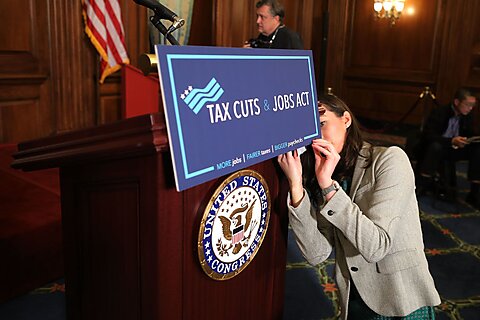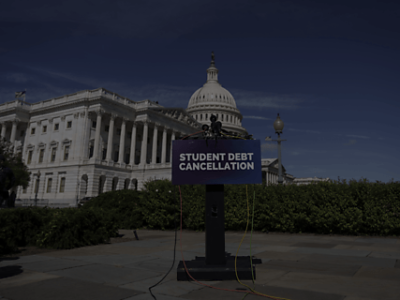
Adam N. Michel and Josh Loucks
It has been nearly seven years since the Tax Cuts and Jobs Act (TCJA) was signed into law in December 2017. Most of the law expires at the end of 2025 when taxes will increase by more than $400 billion a year, hitting Americans at every income level.
As Congress debates the future of the tax code, it is also important to revisit key questions about the past. There remain many misperceptions about the 2017 reforms. Clarifying a few central questions will allow policymakers to pursue better policy for 2026 and beyond.
The TCJA cut individual and corporate tax rates, shifted more than 29 million Americans to the simpler standard deduction, consolidated family tax benefits, and overhauled the international tax system, among many other reforms. However, the law was not perfect. For example, the vast majority of the individual tax changes and crucial incentives for investment are temporary, blunting the economic effects and hiding the law’s true fiscal cost.
The following piece answers some of the most commonly asked questions about the TCJA. They include:
Who received a tax cut?
Who received the biggest tax cut?
Did the SALT limit raise taxes on the middle class?
What’s the difference between tax reform and tax cuts?
Did the tax cut affect the economy?
Did workers see wage increases?
How much did the tax cut add to the deficit?
You can download a consolidated one‐page version of these FAQs and a summary of all the major tax changes here. For a compendium of future tax reform options for Congress to build on the success of the TCJA in 2025, see the recent Cato Policy Analysis, “Slashing Tax Rates and Cutting Loopholes.”
1. Who received a tax cut?
The tax code has seven income tax brackets, which tax Americans at progressively higher rates as they earn more income. The TCJA cut the top rate from 39.6 percent to 37 percent, intermediate rates were also cut, and bracket thresholds—the points at which income is taxed at higher rates—were expanded so that more income is taxed at lower rates.
Combined with all the other changes in the law, the Tax Policy Center estimated that the tax cuts would result in 80 percent of taxpayers receiving a tax cut and 15 percent seeing no change in taxes paid. Five percent of taxpayers were estimated to pay more in 2018 than they did in 2017.
2. Who received the biggest tax cuts?
Estimates from the Tax Policy Center and the Heritage Foundation indicate the average taxpayer received a tax cut of roughly $1,500 and double that for a family of four in 2018.
The top 10 percent of taxpayers pay about 76 percent of the income tax. The lowest‐income half of taxpayers pay 2.3 percent of income tax collections. Because of this imbalance in who pays the majority of the tax burden, the highest‐income Americans benefited from the largest tax cuts in dollar terms. It is hard to cut taxes for people who already aren’t paying any income tax.
A more informative way to look at the distribution of tax cuts is as a portion of what people were already paying. Figure 1 uses IRS data from before and after the TJCA to show that the largest tax cuts went to Americans in the bottom 75 percent of income earners. The lowest‐income 50 percent of individuals saw a 9.3 percent reduction in their tax bill, compared to a 0.04 percent tax cut for the highest‐income 1 percent.
3. Did the SALT cap raise taxes on the middle class?
In 2017, taxpayers who chose to itemize and were not subject to the alternative minimum tax (AMT) could deduct their full state and local tax (SALT) payments from their federal income. The TCJA limited the SALT deduction to $10,000. So even if only 5 percent of all taxpayers paid higher taxes, there could be significant variation across the country, with higher income and higher tax areas being hit harder.
A Heritage Foundation analysis looked at the tax cuts by congressional district and found no district had more than 12 percent of taxpayers with a tax increase. Those who did see tax increases tend to be high‐income earners.
For most taxpayers, the SALT cap was more than offset by a larger (almost doubled) standard deduction and lower tax rates. Due to the tax code’s complexity, many higher‐income Americans may also not have realized that changes to the AMT also offset the SALT cap. (The AMT is a parallel minimum tax system with slightly lower rates and fewer deductions, including full denial of the SALT deduction.) Raising the AMT exemption limit reduced the number of AMT taxpayers from 5.3 percent to less than half a percent. For these taxpayers, the SALT deduction increased from $0 to $10,000.
4. What’s the difference between tax reform and tax cuts?
A tax cut lowers tax rates, increases deductions, or expands tax credits to lower tax revenue. Tax reform can also cut taxes but, more importantly, includes significant measures that improve the tax base and simplify complex provisions.
On net, the TCJA lowered revenue by about $1.5 trillion over ten years. However, the Joint Committee on Taxation estimated more than 60 different changes to the tax code that increased revenue by approximately $4 trillion. The higher revenue from base broadening and other one‐time changes allowed the TCJA to cut taxes by $5.5 trillion on a gross basis. Figure 2 summarizes categories of provisions with the largest changes in revenue in the 2017 law.
5. Did the tax cut affect the economy?
Not all tax cuts are created equal. Some tax cuts—like individual and business tax credits—put money back in people’s pockets or pad industry profits but have only small effects on the long‐run trajectory of the economy. Permanent tax cuts that improve incentives to work and investment tend to have the largest effects on long‐run economic growth.
The most economically powerful changes in the TCJA were the reduction of the corporate tax rate from 35 percent to 21 percent and the allowance of full deductions for business investments (called full expensing).
Estimates of the law’s economic effects from independent organizations found that TCJA would increase investment (growing the capital stock) and boost GDP by between 0.8 percent and 1.7 percent. Multiple years after the law took effect, empirical investigations of the actual economic outcomes have confirmed positive economic results.
Kyle Pomerleau and Donald Schneider find that in the years immediately after 2017, “real GDP, consumption, business investment, and payrolls grew more rapidly than expected” by pre‐reform forecasts from the Congressional Budget Office (Figure 3). Gabriel Chodorow‐Reich and coauthors use variation in how firms were impacted by the tax cuts to estimate the TCJA will result in a long‐run increase to the capital stock of 7.2 percent, roughly 50 percent larger than some of the most optimistic projections. This result implies a positive overall economic impact larger than the consensus range.
6. Did workers see wage increases?
Wages rise when workers are more productive by using new tools and technologies. Tax cuts that are designed to increase investment are thus also designed to raise wages by making workers more productive. Much of this effect will be realized over many years and is likely still playing out today.
Estimates of the law’s effect on wages ranged from a roughly $550 to $2,000 increase in annual personal wages over time. Immediately following the tax cuts, there were clear indications that the labor market improved, including a significant increase in wage growth at the beginning of 2018. Compared to the pre‐TCJA wage trend, the average production and nonsupervisory worker received about $1,400 more in above‐trend annualized earnings as of April 2020 (before the pandemic disruptions).
7. How much did the tax cut add to the deficit?
The Joint Committee on Taxation estimated the TJCA would add $1.5 trillion to the deficit over ten years. The Tax Foundation found that accounting for the dynamic effects of economic growth, the ten‐year deficit effect would be $448 billion, more than $1 trillion less than the official static estimate.
Because significant portions of the law are temporary, it is hard to assess its long‐term budgetary impact. However, the dynamic revenue projections from 2017 indicate that federal revenues would break even in 2023—before most provisions began expiring. In this sense, the tax cuts were a one‐time addition to the debt and not an ongoing contributor to the deficit. However, making the law permanent would lead to a multi‐decade reduction in tax revenue and expansion of the deficit on an ongoing basis.
Congress should prioritize keeping taxes from rising, but any tax cuts must be paired with spending cuts or other reforms to ensure low taxes remain permanent. Since the 1980s, tax revenue has remained relatively stable as a percentage of GDP. Figure 4 shows that since 2000, Congress has allowed spending to grow faster than revenues and significantly faster than the economy. These trends are unsustainable, but raising revenue alone cannot fix out‐of‐control spending growth.






